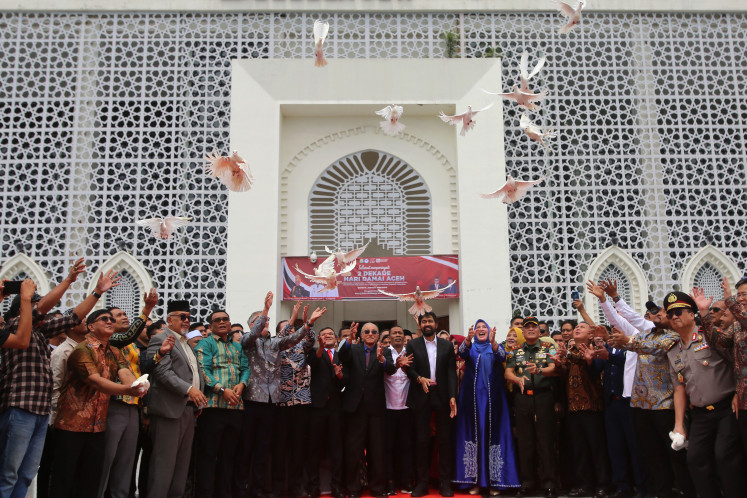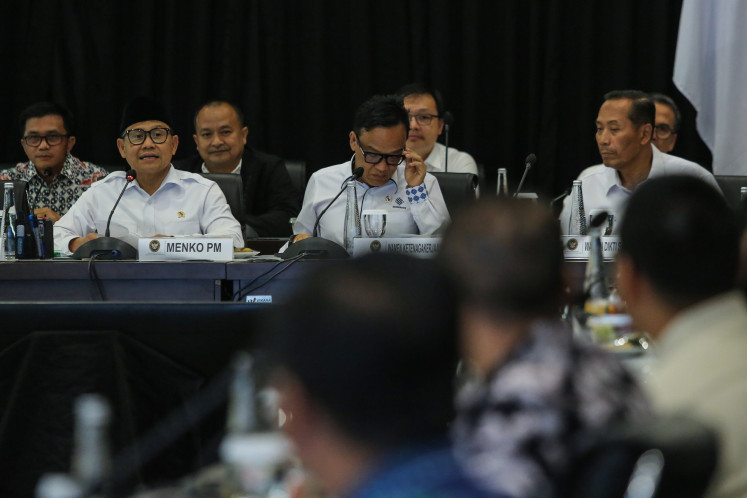Popular Reads
Top Results
Can't find what you're looking for?
View all search resultsPopular Reads
Top Results
Can't find what you're looking for?
View all search resultsInsight: Mental revolution vs oil mafia
In the past few weeks there has been a lot of discussion about the oil mafia
Change text size
Gift Premium Articles
to Anyone
I
n the past few weeks there has been a lot of discussion about the oil mafia. Maybe this was triggered by concerns about the fuel supply, but when the Corruption Eradication Commission (KPK) named former energy and mineral resources minister Jero Wacik as a corruption suspect, the public realized there was a mafia in the oil industry. To fight this oil mafia, the government must lead a concerted effort. The industry needs a mental revolution.
Corruption in our oil and gas industry dates back to the oil boom in the early 1970s, when OPEC's oil embargo caused oil prices to surge to new levels. The oil and gas industry was administered by the government through Pertamina, which certainly enjoyed windfall profits.
Poor management, many government interventions and a large windfall profit turned out to be a deadly mix for Pertamina. Using this windfall profit and in the name of national economic development, Pertamina made many unwise investments and expended capital. The party quickly ended in 1975 when the state oil company almost went bankrupt with over a US$10.5 billion debt burden, and the government had to bail out Pertamina.
The Oil and Gas Law of 2001 terminated Pertamina's monopoly, turning it into a corporate entity but still wholly state owned. All regulating authorities were transferred to the now dissolved Upstream Oil and Gas Executive Agency (BP Migas) for the upstream industry and the Downstream Oil and Gas Regulatory Agency (BPH Migas) for downstream operations. The oil mafia, groomed during Pertamina's monopoly, started to feel the pinch.
While BP Migas was still in place, we rarely heard of a major corruption case (as a result of oil mafia involvement) in the upstream oil industry. Part of this success was attributed to R. Priyono's initiative to have formal cooperation between the KPK and BP Migas, under which a KPK official was assigned as part of BP Migas' management. By doing so, corruption could be minimized at the source.
The oil mafia gained the upper hand again when the Constitutional Court decided to dismantle BP Migas. The government quickly formed a new regulatory body called the Upstream Oil And Gas Regulatory Special Task Force (SKK Migas) as a transition institution to replace BP Migas. However, eight months later SKK Migas head Rudi Rubiandini was caught by the KPK accepting bribes. Less than two years later the energy and mineral resources minister was also indicted in a different corruption case. The oil mafia won the game and two senior government officers were trapped in the middle of it.
In the downstream industry, the oil mafia is much stronger. For example, in crude oil importation, the oil mafia dominates the supply of crude oil to Pertamina. Even though crude oil is refined partly to fulfill the domestic supply of subsidized fuel, the decision to import crude oil, the type and quantity, remains in the hands of Pertamina's management. No one but Pertamina has the technical ability to judge the soundness of crude oil imports.
Because two major Pertamina refineries (Balikpapan and Cilacap) use cocktail crude feedstock, the crude being refined can vary. A cocktail feed stock without a firm (long term) baseline crude certainly gives wider room to design an ad-hoc crude mix. A refinery can decide to use a different baseline crude that is more suitable to certain types of crude each time the refineries make their monthly refining plan.
By using a different combination of crude, the refinery can give an economic calculation that favors certain types of crude. Once a refinery has worked out its feedstock scenario, the Petral company is then instructed by Pertamina management to procure crude oil. Thus, most of the time, the crude bought by Petral is that held by the oil mafia. It is all by design, not by coincidence.
The presence of an oil mafia and corruption are also felt in the import and distribution of subsidized fuel and liquefied petroleum gas (LPG). The government gives a monopoly privilege to Pertamina to procure and distribute subsidized fuel and LPG. As domestic production cannot meet domestic demand, much of this fuel and LPG has to be imported.
As a matter of trading convenience, Pertamina assigns this procurement task to Petral. Petral conducted its procurement through a tender, but various sources say most supply orders were given to a group of related companies, namely oil mafia members.
The distribution of subsidized fuel and LPG are also problematic. The huge price disparity in the domestic market between subsidized and non-subsidized fuel and LPG creates room for theft and illegal trading.
The oil mafia has always used Pertamina as its operations' centerpiece. Thus, one key to fight the oil mafia is to reform, restructure, reengineer and reposition Pertamina. The new Pertamina CEO should have strong technical proficiency and impeccable integrity.
We can also learn from the experience of BP Migas under the leadership of R.Priyono. Deterrence and prevention are always better than fighting the oil mafia and corruption. The presence of KPK personnel in BP Migas proved to be successful in discouraging the oil mafia.
___________
The writer, a Harvard University alumnus, is founder and director of the PPRL Group, an Indonesian oil company. The views expressed are his own.










